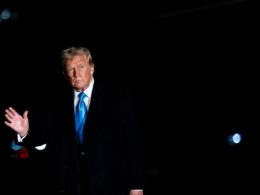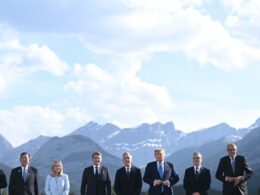It may be the worst economic policy in American history, but it’s now law. President Donald Trump signed his ‘Big, beautiful bill” the week before last, and although business always likes a tax break in the short term, the US economy will be the poorer for it longer term. What will the BBB mean for markets? That’s the question I’ll pose for my Swamp Note partner this week, investor Jay Pelosky, head of TPW Advisory.
First, let me lay out the main political and economic implications of the bill. Let’s start with the fact that the bill’s logic (to the extent that there is logic here, rather than just self-interest) is based on trickle-down theory. In other words, the President’s Council of Economic Advisers are arguing that giving the wealthiest Americans and big businesses tax breaks will create jobs by stoking animal spirits.
The problem is that this hasn’t happened for decades now. I’ve personally built a career and written three books off research showing that tax cuts haven’t created broader economic prosperity. Rather, trickle-down policies have incentivised private debt bubbles and created more inequality which ultimately dampens economic growth.
But you don’t have to go into the archives to understand this; rather just look at Trump’s first-term tax cuts, which went not to Main Street but to share buybacks. These buoyed the market but did almost nothing for real economy capital expenditure.
This time around, the tax breaks for private equity, like the continuation of carried interest loopholes, and all the other rich people boondoggles in the bill will be covered by big cuts to Medicaid. There are also cuts to other major social programmes like SNAP, aka food stamps. This is a bold political move, because as even some Republicans have noted, these cuts are going to hit poor people in red states, including much of Trump’s Maga base.
In this sense, the BBB will be an important litmus test of where our politics truly are. I’ve always thought that Maga was a mix of people drawn to the president for cultural reasons (those who are insular at best, racist and xenophobic at worst), and those who believe that the economic pain they’ve endured hasn’t been addressed properly by the mainstream of either political party.
The scholar of social inequality Joan Williams has argued in her new book Outclassed that some 19 per cent of Trumps’ base is neither racist or xenophobic, but is rather “anti-elite,” meaning that they don’t buy into neoliberal politics as usual.
So what happens now that Trump is handing them the most neoliberal bill we’ve ever seen? What happens when the healthcare emergencies no longer covered by Medicaid and the groceries not paid for by SNAP mean that the kitchen table maths for these folks no longer works?
Do these voters turn away from Trump as his policies take away their paltry safety nets while they also keep inflation high? I’m talking not only about tariff worries but the way in which the BBB is stoking concerns about a serious debt crisis and the “EM-ification” of America. If they do, then Democrats have a shot at reclaiming these people in the midterms and the 2028 presidential election with some smarter progressive economic policies — though not Zohran Mamdani-style sloganeering populism (for more on the lessons there, read my Monday column).
But if the BBB doesn’t force at least some of Maga away from Trump, then I fear we are heading to a much darker place politically.
Jay, I can pontificate about the political economy, but you have skin in the game. Do you agree with my analysis above? And if the US is in for a period of stagnation at best, what’s the play for investors?
Recommended reading
-
This front page NYT piece on rightwing influencer Laura Loomer is required reading to understand how things are operating in the White House these days.
-
Zeynep Tufekci’s column on how Doge cuts played into the recent deaths from Texas floodwaters shows why unglamorous parts of the government are sometimes the most crucial.
-
Two important long-form pieces in the FT: first, this Big Read from Claire Jones on Trump’s politicisation of the Federal Reserve and the impact it could have on markets. And from a week or so ago, historian Peter Frankopan’s essay on the partnership between Xi’s China and Putin’s Russia is an excellent take on the alliance that may reshape the world.
Jay Pelosky replies
Thanks Rana, I appreciate the chance to engage with you on this subject. I think you have correctly described the Trump bill as being strongly tilted in favour of the wealthy. When one adds tariffs to the mix, the combined effect is very regressive and arguably anti-growth and pro-inflation.
Brendan Greeley wrote an interesting FT Weekend piece arguing the US has a version of “Dutch disease”, which traditionally refers to those countries with commodity export driven economies. Greeley suggests that over the past 25 years the US has been exporting its current account deficit, noting that since 2000 US debt has grown from $7tn to $36tn, as the world sought dollars and America was more than happy to provide them. Note this global demand for dollars followed the foreign exchange crisis in emerging markets driven by a dollar shortage in the late 1990s.
Trump’s bill adds some $3.4tn debt over the next decade. This is where it gets interesting to me as a global macro investor. As I see it the Trump bill cements the US position as the world’s leading debtor with 7 per cent budget deficits for the foreseeable future, exposing US dependence on other countries to absorb the ever-flowing dollar just as that appetite wanes.
Trumpian policy uncertainty coupled with his America First agenda has awakened Europe and Asia to the urgent need for significant policy action of their own to compensate. This combination of positive policy action abroad and poor policy action at home makes one wonder about the sustainability of that dollar absorption.
Our Tri Polar World framework (the TPW in our name) suggests an evolution to a world of regional integration in the three main poles of Europe, Asia and the Americas. This process was sped up by Covid and the recognition of the need for the so-called nearshoring, friendshoring and reshoring of supply chains. Trump is another accelerant of this process, as evidenced by Europe’s sudden awareness of the need to defend itself leading to massive fiscal spending in Germany.
In Asia, China is focused on generating more domestic demand-driven growth rather than stoking its export engine. Leading Chinese officials are now talking about the need to become a massive domestic consumption engine while reducing excess production, averting deflation and further integrating south-east Asia.
As I see it the past few years have witnessed a focus on regional production across the TPW in AI, climate and defence. Today, the US is focusing on raw material production as a national security necessity, with Trump threatening 50 per cent tariffs on copper imports and the Pentagon taking an equity stake in a US rare earth producer.
Perhaps most interesting is the TPW’s evolution into regional foreign exchange blocs, as Christine Lagarde, European Central Bank president, declares a “global euro” moment and the Chinese articulate the virtues of a multi-polar currency world with a more accessible renminbi for both domestic and foreign investors. The euro for Europe, the renminbi for Asia and the US dollar for the Americas.
Such a world would leave the US in a relatively poor competitive position given Trump’s bill just cemented its dependence on foreign capital inflows. Capital staying home helps Europe and Asia and hurts the US.
If Europe invested its capital at home to build out its defence and AI capabilities rather than funding the US deficit or if the Chinese became a massive domestic demand consumption engine the US would suffer, mainly through the devaluation of US assets leading to a weaker dollar, higher rates and cheaper stocks.
Europe could be the big winner as money stays home. A deeper capital market coupled with the development of a European safe asset would ensure cheaper EU funding and thus a higher potential growth rate. We note that Germany has the fiscal space for this build-out, as China does within Asia.
How should investors participate? I believe we are early in a secular global equity leadership change away from the US (the leader since the global financial crisis hit bottom in 2009) to the rest of the world. This leadership change is likely to be underpinned by a sustained period of capital repatriation out of the US back to Europe, Asia and emerging markets to fund their own build-outs.
Today is arguably the best time in the past 16 years to be a global investor. Emerging market assets, both debt and equity, should be big winners as a weak dollar makes space for central banks in those markets to cut rates and sustain their economies without fear of foreign exchange meltdowns. Commodities should also do well — gold has already broken out, copper is joining it and energy acts very well.
The Tri Polar World of regional integration in Europe, Asia and the Americas to compete across AI, defence and climate is a more balanced world, one where investors would be well advised to have a diversified exposure across global equity, foreign currency and commodities.
See more of Jay’s work on Substack at The Tri Polar World
Your feedback
We’d love to hear from you. You can email the team on swampnotes@ft.com, contact Rana on rana.foroohar@ft.com, and follow her on X at @RanaForoohar. We may feature an excerpt of your response in the next newsletter
Source link









